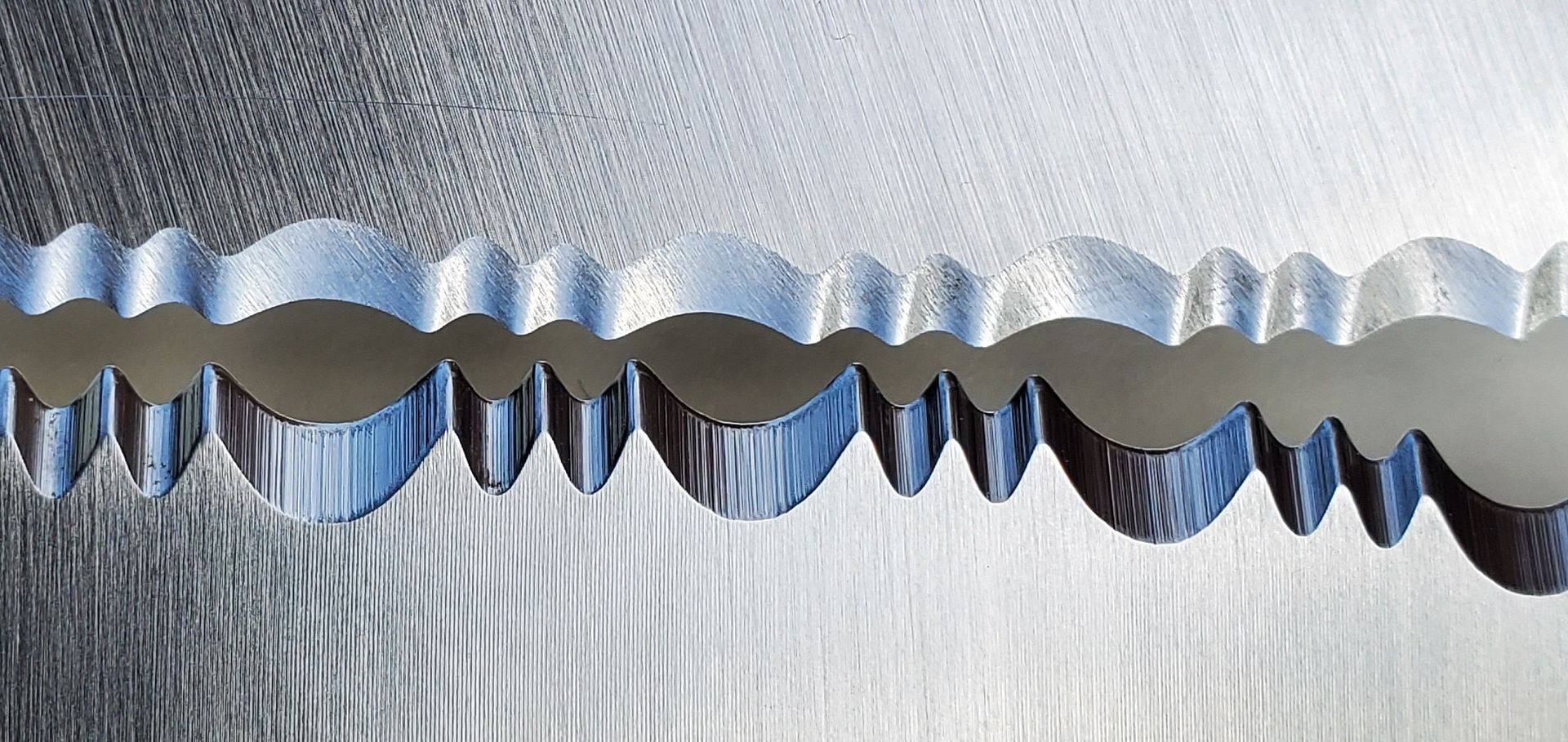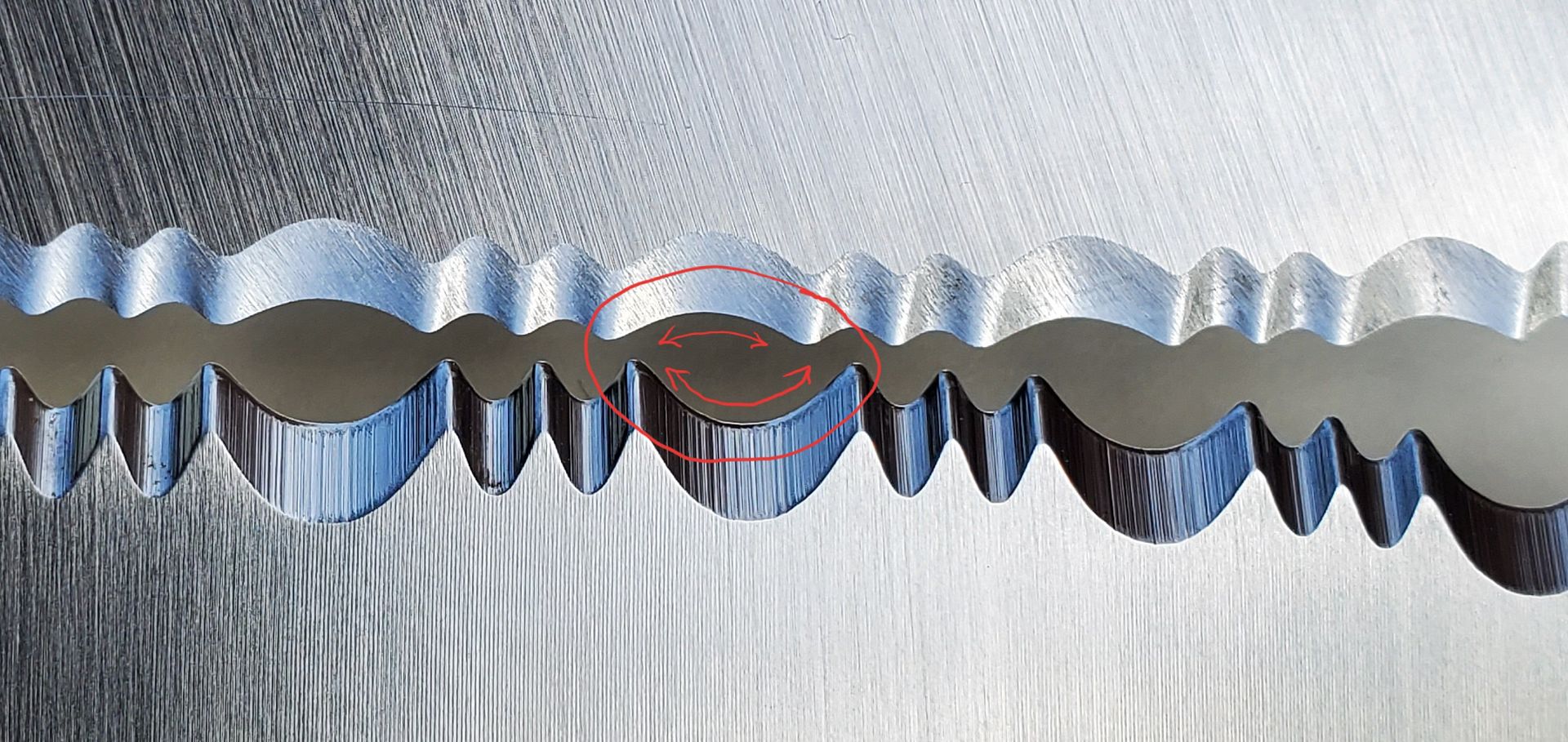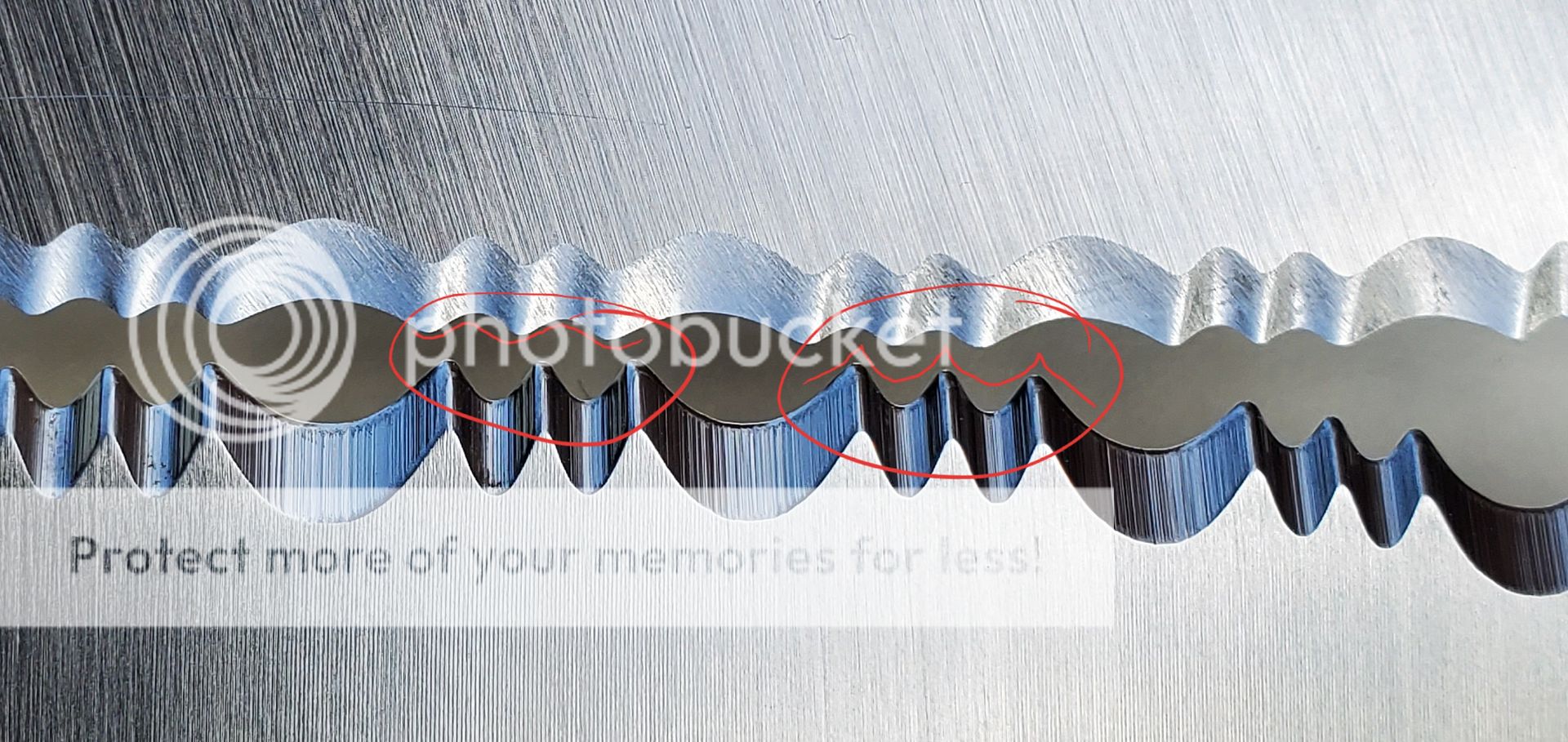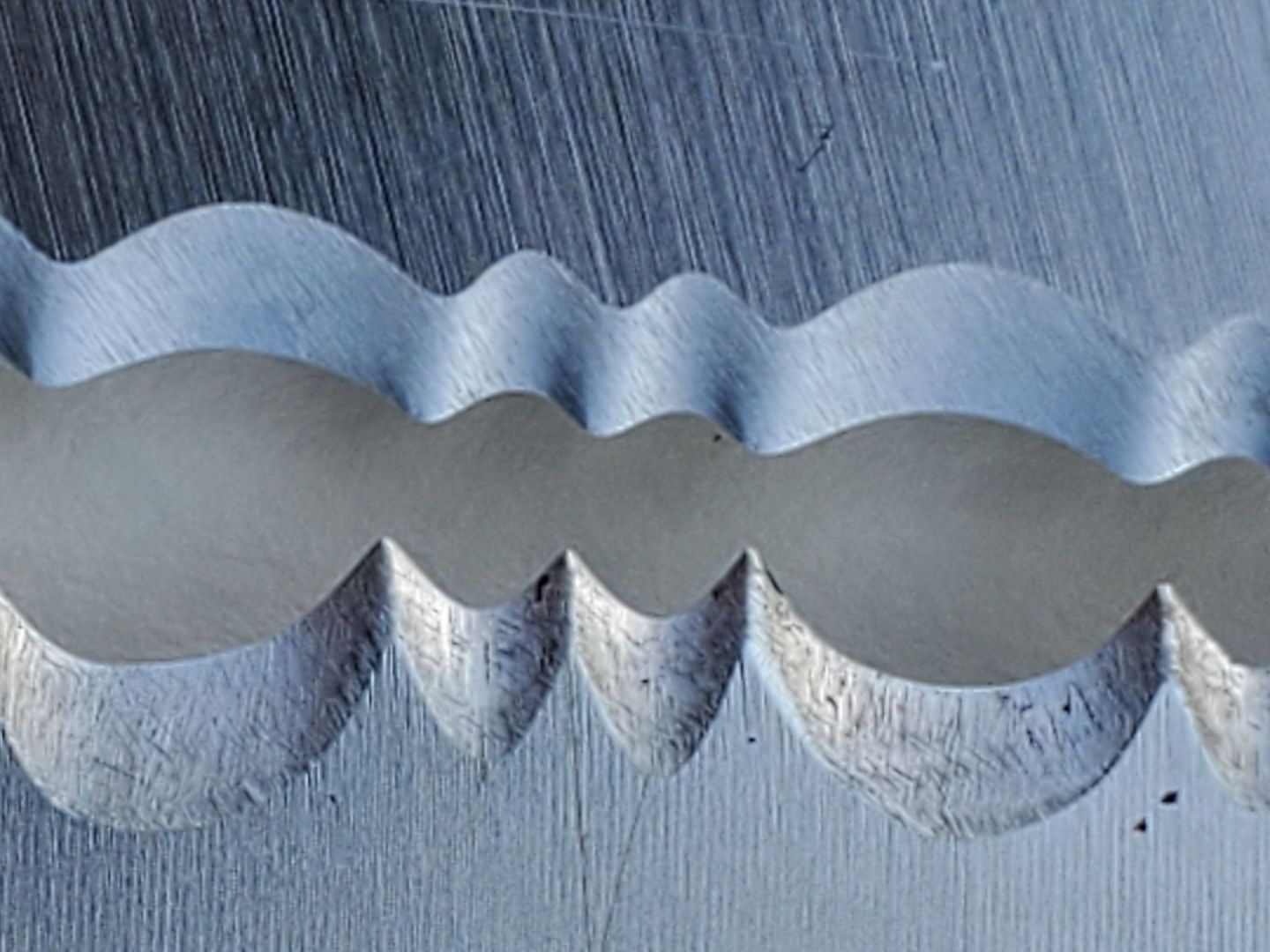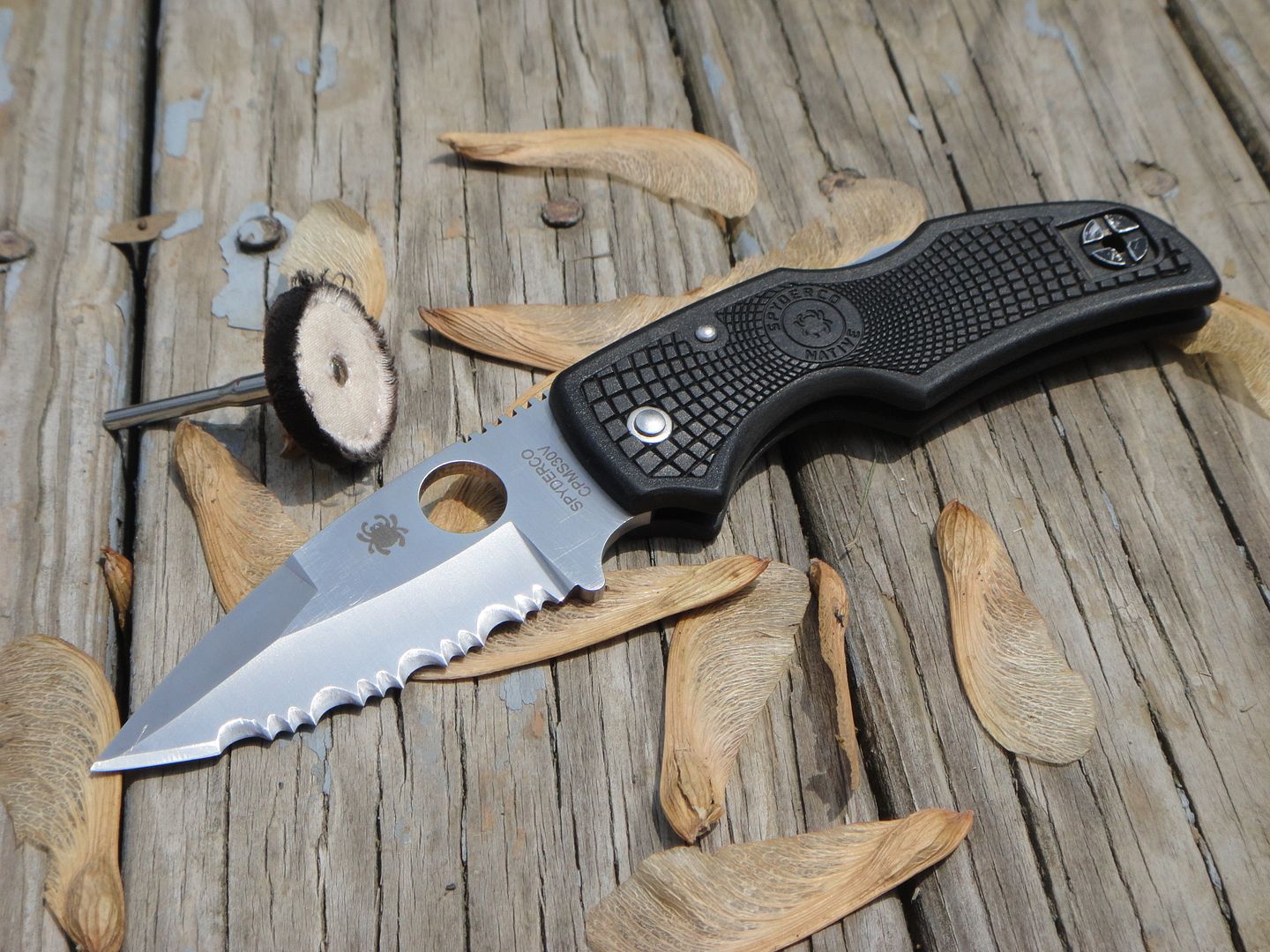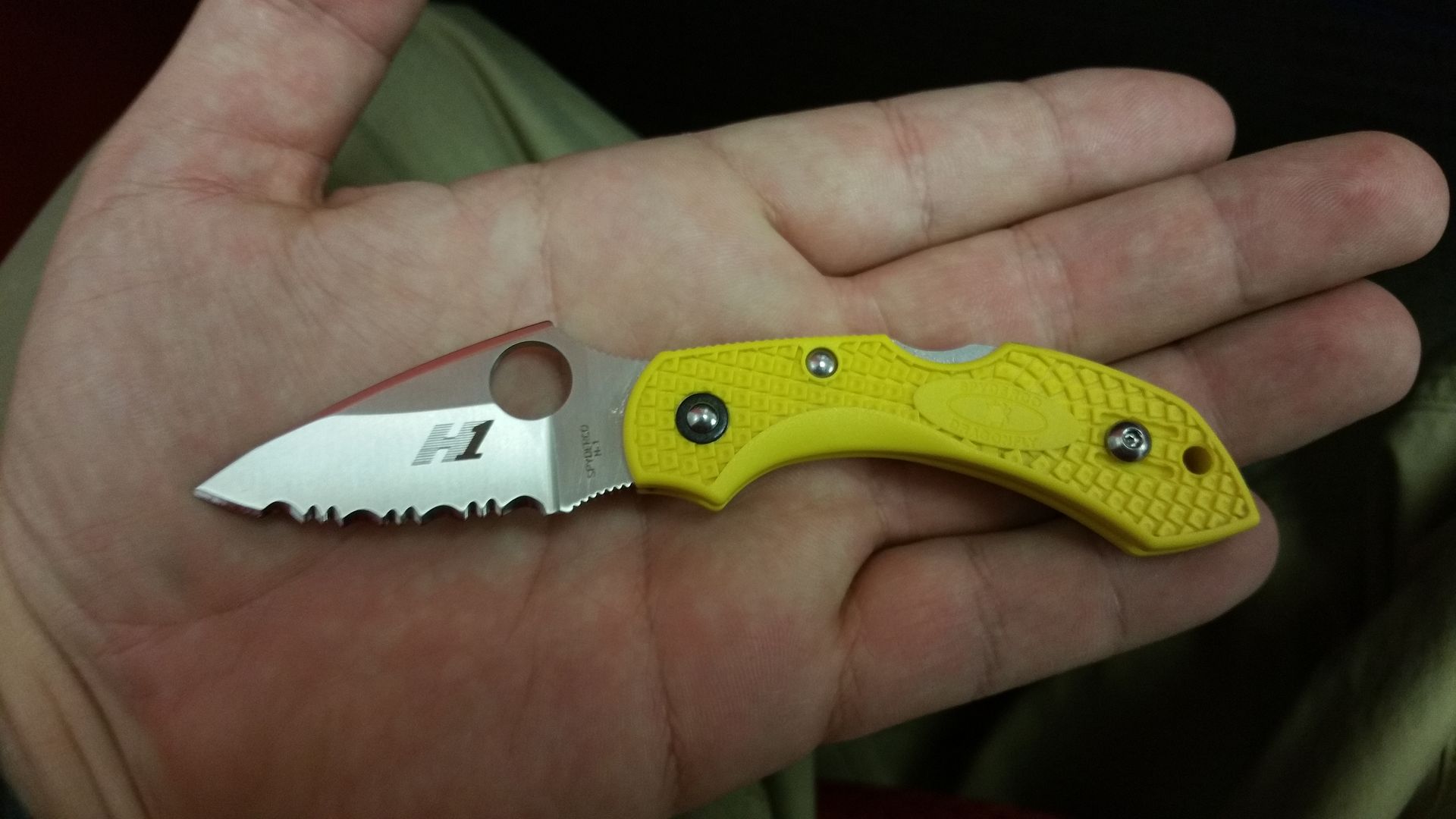This was definitely not what I was expecting this topic to be about, but wow, that is a lot of useful information in one post, even 4 years after the fact. I unfortunately don't have time currently to read all 50 pages of this thread, but there is a lot of great information in this.Evil D wrote: ↑Tue Oct 01, 2019 12:23 pmtl;dr
SE are the bees knees and you need to get with the program. Just as with PE knives, not all SE knives are created equally and different combinations perform better than others. Towards the end there's a bit of why I'm bothering with all this if you'd like to read that.
For sharpening tips go here viewtopic.php?f=2&t=84544
*What separates great performing SE from poor performing SE*
First lets just lay it out there that there is more to a serrated edge than just having teeth. We've had some discussion in the past about exploring serration patterns (JD I'm looking at you) but even within the already established pattern of "large/small small/large" that Spyderco uses, there are variations in size/depth/curve to the serrations themselves, and then those variations are also combined with blade grind and thickness, and you end up with a LOT of variables of what make a knife slice well or snag or whatever. For now lets leave out the differences in steel and edge retention etc and just focus on the serrations themselves.
I feel that I have a pretty decent representation of those variations here:
The only thing I lack is a much thinner option like the Catcherman (JD I'm looking at you).
Unfortunately nearly all of my SE knives have been sharpened to some degree, some more than others and that sharpening has definitely effected performance (more on that later). This makes comparisons a little "unfair" but the differences are still easy to see.
Lets start with looking at the differences in SE shape. Here we have a thoroughly reprofiled and sharpened Caribbean on top vs a near factory edge Military (only sharpened on white rods) on bottom:
Look close and lets break down three of the biggest contributing factors in how SE cut/slice/snag/excel/fail.
1) Depth of the curve:
Depth of the curve can be thought of as hawkbill vs recurve. Which blade shape is going to hook material more (and in doing so, create drag/resistance)? Just like a hawkbill, I think there is a happy middle ground here, where too much is going to limit or reduce performance while not enough is defeating the purpose. Too much and you may as well have a hawkbill, and too little may as well be a Kriss. More hook may create a more aggressive cutting action, but it will also create resistance in doing so, and if you combine it with the other two factors we're looking at you'll end up with a snagging/poor slicing knife. This detail by itself I think contribues the least to poor performance out of the three.
2) Depth of the serrations INTO the blade, AKA thickness of the blade AT the serrations:
Look at how shallow the ridges are on the Caribbean vs the Military. This seems to be confused or combined with the depth of the curve, but they are not really related. The depth of the grind into the blade has more to do with how thick the blade grind is at the bottom of the blade. This results in very tall "ridges" between the serrations that are quite thick and cause biding and drag. This feature seems to be much more common on older models like this Military and my Stretch. By comparison though, the Stretch has a significantly thinner blade grind at the bottom of the blade where the serrations are cut into, which results in shallower cut serrations and less dramatic ridges. I don't like to think of this as the same as "behind the edge thickness" because you could measure it at the top of the large serrations and again at the top of the valleys between the serrations and get two very different thicknesses, despite both of them technically being "behind the edge". This one detail has a big impact on slicing since the blade is ground thick and snagging since the ridges between the serrations are so thick. Despite the fact that the edge is sharp, the resulting thickness of the blade grind is not going to slice well regardless of SE or PE.
3) Pointy vs round AKA sharpness of the teeth:
The two biggest contributing factors I've experienced that lead to poor performance and snagging are 1) dullness and 2) sharp/pointy teeth. Those sharp/pointy teeth are going to do a lot more scratching than cutting because if they come to a literal point then they don't have an edge anymore. I can imagine some scenarios where sharper/pointier teeth could have an advantage when trying to penetrate into material, but then you're also looking at more of a push cut into the material rather than slicing, and then you're pressing the whole blade through something in a push cut, and in two years of carrying nothing but SE I haven't once encountered anything like that. Once your push cut starts making more of a slicing motion, that's when those points start to scratch instead of cut and that's where rounded teeth have an advantage because they actually have an edge at the very tip of the teeth and that edge will cut before it snags. Also consider that these macro shots make the rounded teeth look more round than they really are...they are still pointy enough to push cut into what you're cutting.
*Blade grind and blade stock thickness*
Bottom line here is, the same rules that apply to making a good slicing PE blade also still apply to SE. You can't lump this into simple categories because there are too many variables. It's more than just "FFG vs X grind", it's more than just "thick blade stock vs thin blade stock" because you can have different combinations of any of those plus the three factors up above and get any number of end results. It's more complicated than just making everything FFG, otherwise the Military and Caribbean from the previous pic would perform the same, but let me tell you they are day and night different from each other in how well they slice and how much they snag. Personally I prefer FFG and thinner blade stock and a blade grind that is thin at the serrations, as I think that combination is the best all around performer.
With that said, some of those factors emphasize and make better/worse some of those 3 factors that effect SE performance. If you have a thick blade stock with a low saber grind that's thick at the edge you'll end up with serrations that are ground very deep into the blade with very thick ridges between the serrations and it isn't going to slice as well as a thin blade stock FFG blade that is super thin at the serrations. If you then take that thick saber blade and give it sharp scratchy serrations, you end up with a frustrating snag fest. It will still cut things, but nowhere near as well as that Caribbean. Ultimately if you start with a blade that will slice well in PE, it should still slice well in SE if you give it the right serration geometry.
*Sharpening, the effects of sharpening to the geometry of SE, and how you may be sabotaging yourself.*
I'm just gonna throw it out there and say, if you've had poor experience with SE, you were probably using a dull knife and/or the knife you were using had some kind of poor combination of those factors we just talked about or all of the above. I'm sure some of you know how to sharpen SE and you still just don't like it and that's fine. This thread isn't for you. This thread is for those who have been mislead and fed negative hype by people who were defeated by those bad factors. Lets break down some good and bad sharpening habits you may have done/heard of and how they effect the performance of SE.
Here we have a Caribbean on top, and a Native on bottom:
You don't need to be a rocket scientist to look at those two edges and figure out which one is going to slice well and which one is going to be a snag fest. In fact I like to call that Native "SNAGgletooth". That knife started out already having sharp teeth and a deep SE grind and the low/thick hollow saber grind all combine to make a knife that didn't slice very well to begin with, but then it was also my first attempt at sharpening serrations and is the victim of some not so great ideas. I started out just looking for a way to get repeatable sharpening results, and I was using a tapered diamond rod to get into each serration. This did work and the knife did get very very sharp after some Dremel stropping, but the knife also continued to snag everything. I wouldn't go so far as to say the knife sucked, but I guarantee that ANY of you could do the Pepsi challenge blindfolded with this Native and my Caribbean and you would choose the Caribbean as the better cutting knife.
The bottom line here is GET A SHARPMAKER. If you know how to use a Sharpmaker already, and you can effectively put a sharp edge on a PE knife with it, then you already know enough to effectively sharpen SE. While there are some extra bits of tips and tricks out there, the same basic concept is the same and if you simply follow what Sal says in the Sharpmaker video you WILL get screaming sharp SE edges. Where I take that a bit further (and actually break some of Sal's rules from that video) is I deliberately sharpen down and round off the tips of the serrations with diamond rods and then go through a full brown/fine/ultra fine grit progression. This helps to not just round off the points so they scratch and snag less, but if you go so far as to reprofile the whole SE grind you'll also smooth down some of the ridge between the teeth which reduces drag in a slicing motion (props to Vivi for this one).
Now, that's not to say that other sharpening tools are ineffective (I'm looking at you again JD). I'm sure the 701's do a fine job of sharpening serrations, but they will also lead to making the teeth sharper and making the depth of the serrations into the blade even deeper which results in taller ridges between the scallops. Again, this won't make a knife unusable by any means, but if you like a knife that slices and doesn't snag, if you've avoided SE because of those reasons, then you need to stick with the Sharpmaker.
Also, don't be stupid like me, avoid the tapered diamond rod. We're not sharpening a chainsaw. Let me just say it again, buy a Sharpmaker.
How I got here.
I just realized this morning that I passed 20k posts recently and I got a little nostalgic over how I got here. It all started with a SE Native, and it seems fitting that here I am nearly 10 years later and I've come full circle back to SE knives. I have learned...well practically everything I know about knives I've learned in that time and my preferences have been shaped by the knives I've bought and used in that time.
If you were to browse through my posts and read over all those 20k (mostly useless) posts you would see a lot of comments about not liking serrations because they snag and because they're hard to sharpen. Those opinions were 100% based on poor experiences, and I've come to the conclusion that this is probably the case for nearly everyone who dislikes SE, or they're just echoing what everyone else said and they haven't given them a fair chance. I hate to make blanket statements like that, but if I can go all this time disliking something only to prove myself wrong and come to love it then I figure most people could do the same if they kept an open mind and gave SE a fighting chance.
It all started with this knife:
Actually, let me back up just a bit. It really started with the PE version of that same knife, which was the "Walmart Native". So yes, I have Wally World to thank for introducing me to Spyderco. After I bought that knife I researched the brand and got paranoid that it was somehow a fake or a cheaper version since it didn't have the bug logo, and then I read on the Spyderco site about SE and let me tell ya whoever wrote that needs a raise because it sold me on SE and I returned the Walmart version and went to Bass Pro Shop and paid over 2x as much for the SE version. So, a SE knife was the first Spyderco I used and I carried that knife for a few years until it got dull and I had no way of sharpening it so I went back in search for another Spyderco, which was the standard PE Delica, and that was the knife that brought me to this forum.
Present day, and why I only carry SE.
Yes you read that right, October marks two years of nonstop SE EDC. I have modded and played with a few PE knives but for my real day to day uses and what I always have clipped in my pocket, it was an Autonomy for a little over a year and has been a Caribbean ever since that. A couple years ago I tried to do a six month SE only EDC to force myself to 1) learn to sharpen them and 2) find out once and for all if the hype or disdain for SE were true or not. Although that experiment didn't last a full 6 months, I did kinda learn how to sharpen SE (refer to the Native up above) and I did learn to appreciate them more but it wasn't until I finally got a Sharpmaker that it really started to click. Over so many years of carrying PE and talking down about SE, there was this one little SE knife in my collection that went against all odds and I couldn't quite wrap my head around why it performed so well for such a small unimposing little knife.
This knife was the knife that brought me to really love using SE:
That little Draginfly Salt was a beater in every sense of the phrase. I used that knife for work for everything from cutting up boxes to cutting plastic wrap, packaging straps/bands, you name it. I was amazed because it didn't snag and rip like my Native did, and it was a serious power house for being so small. That knife was an unintentional taste of what dedicated SE EDC could be like and it was the knife that really got me thinking about why it was so good, or really why SE wasn't so horrible like everyone said and like I had previously experienced.
So why type out all this crap? Most of you probably didn't read it all anyway. Folks let me tell ya, I do have better things to do. I have developed a weird sort of passion for this particular subject because it has changed my perspective, and I really respect anything that can change me like that. For all of those 20k comments I've made here, there are thousands more posts from other people that have taught me and helped me out along the way and I hope this helps someone else.
I personally prefer PE knives, but I do love SE/ serrated (I don't currently own a Spyderco SE so I can't very well call it a SpydieEdge, unfortunately), regardless, serrated blades have great use. I've honestly been looking into an H1 SE blade for a bit now, just because the reviews for them are amazing. The only full serrated knives I have are from other brands, and unfortunately most of the better ones I had were stolen when my house was robbed in 2019.
I'm definitely going to keep all of this in mind when picking up my SE blade, whatever one that may be.
So, 4 years after you posted this I thank you for taking the time to list your experiences with these knives. It's greatly appreciated by me. It almost reminds me of the difference in band saw blades and their teeth, some with a finer tooth ridge that isn't as deep work better for certain metals to cut vs larger deeper teeth that tend to spin at slower speeds for other metals(best way I can correlate this because of my line of work).
Anyway, thank you for the information. I greatly appreciate it.

